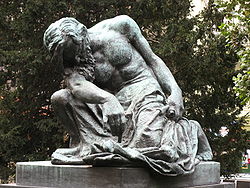
František Bílek
Encyclopedia

Czech people
Czechs, or Czech people are a western Slavic people of Central Europe, living predominantly in the Czech Republic. Small populations of Czechs also live in Slovakia, Austria, the United States, the United Kingdom, Chile, Argentina, Canada, Germany, Russia and other countries...
Art Nouveau
Art Nouveau
Art Nouveau is an international philosophy and style of art, architecture and applied art—especially the decorative arts—that were most popular during 1890–1910. The name "Art Nouveau" is French for "new art"...
and Symbolist sculptor and architect
Architect
An architect is a person trained in the planning, design and oversight of the construction of buildings. To practice architecture means to offer or render services in connection with the design and construction of a building, or group of buildings and the space within the site surrounding the...
.
Bílek attended the Akademie výtvarných umění (AVU) in Prague. Due to his apparent colour-blindness he moved to Josef Mauder one year later (1888) and started to study sculpture. Given a scholarship offered by patron Vojtěch Lanna, he spent one year in Paris at the Académie Colarossi
Académie Colarossi
The Académie Colarossi is an art school founded by the Italian sculptor Filippo Colarossi. First located on the Île de la Cité, it moved in the 1870s to 10 rue de la Grande-Chaumière in the VIe arrondissement of Paris, France....
. After that, he lived in turns in Prague
Prague
Prague is the capital and largest city of the Czech Republic. Situated in the north-west of the country on the Vltava river, the city is home to about 1.3 million people, while its metropolitan area is estimated to have a population of over 2.3 million...
and in Chýnov
Chýnov
Chýnov is a town in the Czech Republic. The asteroid 43954 Chýnov was named after it.-External links:*...
. He was a member of the Mánes Union of Fine Arts
Mánes Union of Fine Arts
The Manes Association of Fine Artists was an artists' association and exhibition society founded in 1887 in Prague and named after the painter Josef Mánes....
from 1898 to 1912.
His works often reflect Biblical themes or have religious connotations. Though it was never completed, Bílek also worked on his National Monument reflecting Czech Hussite
Hussite
The Hussites were a Christian movement following the teachings of Czech reformer Jan Hus , who became one of the forerunners of the Protestant Reformation...
history and its perceived end at White Mountain
Battle of White Mountain
The Battle of White Mountain, 8 November 1620 was an early battle in the Thirty Years' War in which an army of 30,000 Bohemians and mercenaries under Christian of Anhalt were routed by 27,000 men of the combined armies of Ferdinand II, Holy Roman Emperor under Charles Bonaventure de Longueval,...
.
He built his own villa
Villa Bílek
The Villa Bílek is a house designed by the Czech sculptor and architect František Bílek in 1911. The villa is located in Hradčany neighbourhood of Prague, Czech Republic, several minutes walk from Hradčanská metro station or Prague Castle...
in Hradčany
Hradcany
Hradčany , the Castle District, is the district of the city of Prague, Czech Republic, surrounding the Prague Castle.The castle is said to be the biggest castle in the world at about 570 meters in length and an average of about 130 meters wide. Its history stretches back to the 9th century...
which he requested be turned into a museum of his works after his death.
External links
- Radio Prague - extensive Biography and selection of Works
- Guide to Bílek's villa.

